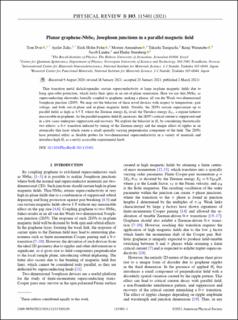| dc.contributor.author | Dvir, Tom | |
| dc.contributor.author | Zalic, Ayelet | |
| dc.contributor.author | Fyhn, Eirik Holm | |
| dc.contributor.author | Amundsen, Morten | |
| dc.contributor.author | Taniguchi, Takashi | |
| dc.contributor.author | Watanabe, Kenji | |
| dc.contributor.author | Linder, Jacob | |
| dc.contributor.author | Steinberg, Hadar | |
| dc.date.accessioned | 2022-03-02T09:50:44Z | |
| dc.date.available | 2022-03-02T09:50:44Z | |
| dc.date.created | 2021-03-03T12:46:32Z | |
| dc.date.issued | 2021 | |
| dc.identifier.citation | Physical review B (PRB). 2021, 103 (11), . | en_US |
| dc.identifier.issn | 2469-9950 | |
| dc.identifier.uri | https://hdl.handle.net/11250/2982364 | |
| dc.description.abstract | Thin transition metal dichalcogenides sustain superconductivity at large in-plane magnetic fields due to Ising spin-orbit protection, which locks their spins in an out-of-plane orientation. Here we use thin NbSe2 as superconducting electrodes laterally coupled to graphene, making a planar, all van der Waals two-dimensional Josephson junction (2DJJ). We map out the behavior of these novel devices with respect to temperature, gate voltage, and both out-of-plane and in-plane magnetic fields. Notably, the 2DJJs sustain supercurrent up to parallel fields as high as 8.5 T, where the Zeeman energy EZ rivals the Thouless energy ET h, a regime hitherto inaccessible in graphene. As the parallel magnetic field H increases, the 2DJJ’s critical current is suppressed and in a few cases undergoes suppression and recovery. We explore the behavior in H by considering theoretically two effects: a 0-π transition induced by tuning of the Zeeman energy and the unique effect of ripples in an atomically thin layer which create a small spatially varying perpendicular component of the field. The 2DJJs have potential utility as flexible probes for two-dimensional superconductivity in a variety of materials and introduce high H as a newly accessible experimental knob. | en_US |
| dc.language.iso | eng | en_US |
| dc.publisher | American Physical Society | en_US |
| dc.title | Planar graphene-NbSe2 Josephson junctions in a parallel magnetic field | en_US |
| dc.type | Peer reviewed | en_US |
| dc.type | Journal article | en_US |
| dc.description.version | publishedVersion | en_US |
| dc.source.pagenumber | 9 | en_US |
| dc.source.volume | 103 | en_US |
| dc.source.journal | Physical review B (PRB) | en_US |
| dc.source.issue | 11 | en_US |
| dc.identifier.doi | 10.1103/PhysRevB.103.115401 | |
| dc.identifier.cristin | 1895285 | |
| dc.relation.project | Norges forskningsråd: 262633 | en_US |
| cristin.ispublished | true | |
| cristin.fulltext | postprint | |
| cristin.qualitycode | 2 | |
